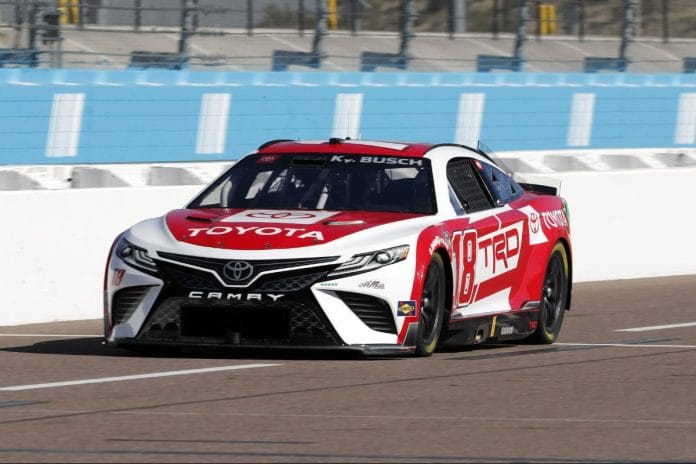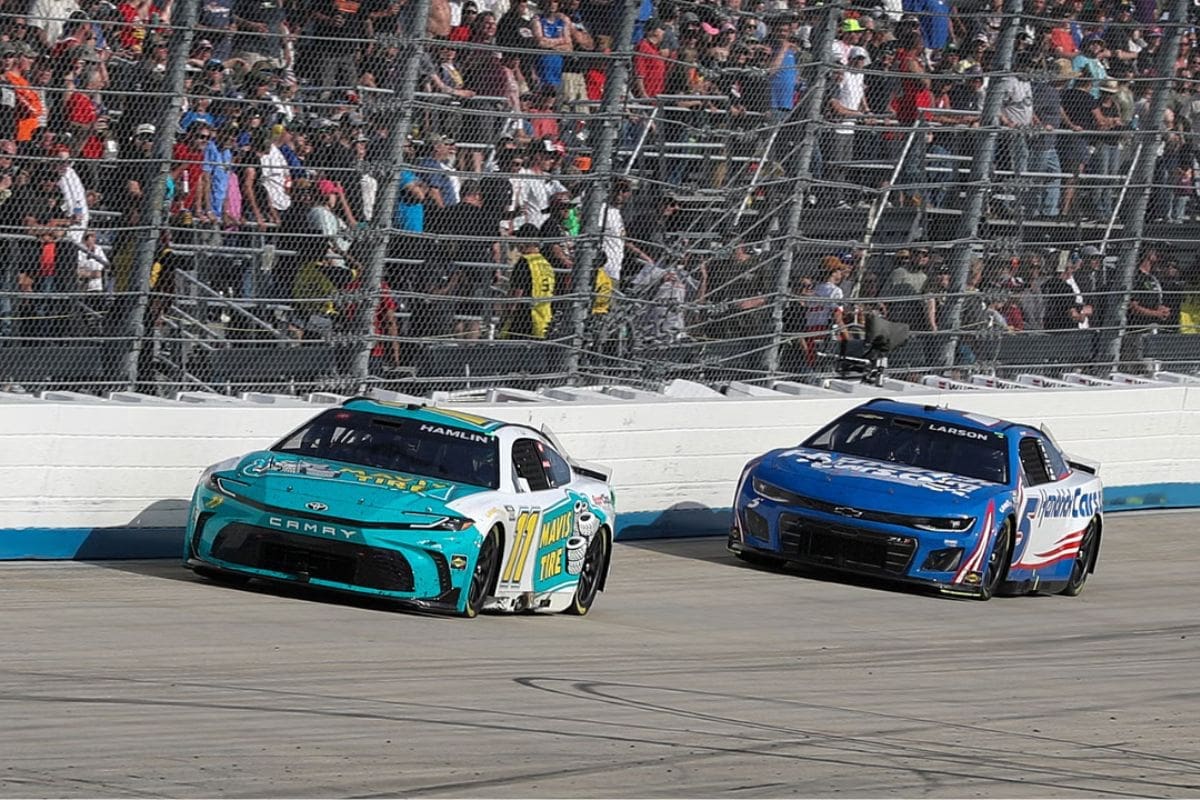Joe Gibbs Racing Reveals NASCAR’s Sole Restriction: Joe Gibbs Racing has announced a notable restriction for the Indianapolis Motor Speedway: drivers are now prohibited from performing celebratory burnouts on the revered bricks. This decision highlights the importance of preserving the historical integrity of a track that has long symbolized motorsports heritage. While the ban aims to protect the iconic surface from potential damage, it raises questions about the balance between tradition and preservation. As the racing community grapples with this new directive, the implications for future celebrations at this legendary venue warrant further examination.
Key Highlights
- Joe Gibbs Racing has announced that NASCAR prohibits celebratory burnouts on the historic bricks at the Indianapolis Motor Speedway.
- The restriction aims to protect the integrity and condition of the iconic brick surface from potential damage.
- This decision follows incidents where burnouts caused significant damage to the bricks, prompting calls for respect towards the historic surface.
- The initiative encourages drivers to celebrate victories while avoiding the bricks, ensuring the preservation of this motorsports landmark.
Kyle Larson’s Brickyard Tradition and the Kiss
Kyle Larson’s recent kiss of the bricks at Indianapolis Motor Speedway not only honors a cherished NASCAR tradition but also signifies the deep connection drivers have with the sport’s storied history. This ritual, representative of victory and respect, allows drivers to pay homage to the legacy of those who have competed on this legendary track. The act of kissing the bricks serves as a reminder of the peak of hard work, dedication, and the relentless pursuit of excellence that characterizes the NASCAR expedition.
The Brickyard 400 is steeped in tradition, with its iconic kissing ceremony marking a noteworthy moment for the winner, their family, and team. This gesture is not merely ceremonial; it shows the emotional and historical importance of the Indianapolis Motor Speedway within the NASCAR community. The bricks, located at the start-finish line, represent not just the physical track but also the spirit of competition that has defined the sport.
Moreover, this ritual reinforces the notion that NASCAR is about more than just racing; it embodies a culture of respect for history and tradition. The meticulous care taken to preserve the bricks highlights the reverence drivers and teams have for this venue. By participating in this ritual, Larson not only celebrates his achievement but also acknowledges the collective history of the sport, binding together past and present in a shared narrative of victory and perseverance.
History and Significance of the Bricks at Indianapolis
Historically, the bricks at Indianapolis Motor Speedway serve as a tangible link to the track’s origins, representing the enduring legacy of motorsports and the deep reverence that drivers and fans hold for this iconic venue. Established in 1909, the original surface was entirely composed of bricks, earning the facility the nickname ‘The Brickyard.’ However, over the years, most of the bricks were covered with asphalt, with only a 3-foot-wide strip remaining to honor this storied past.
The tradition of kissing the bricks, initiated by Dale Jarrett after winning the Brickyard 400 in 1996, highlights the emotional connection drivers forge with the track. The bricks serve as a reminder of the evolution of racing, marking the change from early 20th-century motorsports to the modern era.
The Indianapolis Motor Speedway is not just a racetrack; it is a revered site within American sports culture, attracting fans from around the globe.
Controversy and Protection of the Bricks
The protection of the bricks at Indianapolis Motor Speedway has become a controversial issue within the NASCAR community, as traditions clash with modern celebratory practices. The iconic bricks, symbolizing the heritage of the venue, have witnessed numerous post-race rituals, including the celebrated kissing of the bricks by winners like Kevin Harvick, Jeff Gordon, and Kyle Larson.
However, the contrast of these traditions with the increasingly vigorous celebrations—especially burnouts—has raised considerable concerns about maintaining the integrity of this historic surface. In 2015, Kyle Busch’s burnout on the bricks left an indelible mark, sparking outrage among fans and prompting Speedway President Doug Boles to emphasize the need for respect towards the bricks.
This incident catalyzed a broader dialogue surrounding the preservation of this revered element of the speedway. Following this, NASCAR instituted a clear directive: winners are prohibited from performing burnouts on the bricks, highlighting the sacredness of the site.
Joe Gibbs Racing’s recent video highlighted this restriction, reiterating that the bricks are the sole location in NASCAR where burnouts are strictly forbidden. The organization continues to remind teams of this policy, emphasizing the importance of honoring the rich history encapsulated in the bricks.
“This is the only spot in NASCAR you can’t do a burnout. You don’t want to do any damage or leave tire marks on the yard or bricks. Every year NASCAR reminds the team that when you win, stay away.” – (video caption)
View this post on Instagram

Incidents of Damage to the Bricks
Amidst growing excitement following race victories, incidents of drivers performing burnouts near the iconic bricks have raised concerns about their preservation and integrity. The Indianapolis Motor Speedway, known for its storied history, has witnessed several instances where celebratory burnouts have accidentally caused damage, igniting a debate on the balance between tradition and preservation.
- Jimmie Johnson (2012): The seven-time Cup Series champion performed a burnout that resulted in tearing the bricks, necessitating their replacement.
- Ty Dillon (2014): After clinching victory at the Brickyard, Dillon’s burnout left tire marks and inflicted damage on the bricks, raising questions about post-race celebrations.
in an effort to create more positive discourse on the tl, what’s your favorite nascar burnout of all time?
mine is Ty Dillon Indianapolis 2014: pic.twitter.com/zrqpvYA8Fx
— 🇯🇲1ntern🇯🇲 (@Unpaid1ntern) July 1, 2024
- Kyle Busch (2018): Following his win, Busch’s actions further emphasized the risks involved, as he too came dangerously close to the legendary bricks.
- Justin Allgaier (2018): His burnout after winning the NASCAR Xfinity Series race left visible tire marks on the distinctive 3-foot-wide brick section.
Retweet to congratulate @J_Allgaier for winning at the Brickyard!#LillyDiabetes250 pic.twitter.com/zC0tHA6XRs
— NASCAR Xfinity (@NASCAR_Xfinity) September 10, 2018
IMS Solution and Recent Developments
In response to the ongoing concerns regarding the preservation of the iconic bricks at the Indianapolis Motor Speedway, a tactical initiative was implemented to encourage drivers to perform burnouts away from this historic landmark. This groundbreaking approach, introduced in 2019, not only seeks to protect the integrity of the bricks but also contributes to a noble cause—pediatric cancer research.
The Indianapolis Motor Speedway (IMS) collaborated with Riley Children’s Health to launch the #BurnoutChildhoodCancer campaign, incentivizing drivers to steer clear of the Yard of Bricks. Under this initiative, IMS pledged a total donation of $2,500 contingent on drivers completing burnouts away from the bricks, comprising $1,000 following the Indiana 250 and $1,500 post the Big Machine Vodka 400.
“IMS and Riley will execute a #BurnoutChildhoodCancer promotion and text-to-give campaign. IMS will provide a $2,500 total donation upon completion of burnouts away from the Yard of Bricks, with $1,000 after the Indiana 250 and $1,500 after the Big Machine Vodka 400 at the Brickyard. Fans can text BURNOUT to 52182 to donate the amount of their choice in support of pediatric cancer research.” – (PRESS RELEASE)
This dual focus on preserving a historical site while promoting charitable action has resonated with all the drivers and fans, fostering a deeper sense of community and purpose within the NASCAR framework. Since the inception of this initiative, no incidents have been reported, indicating its effectiveness in maintaining the sanctity of the bricks.
Additionally, the response from fans has been encouraging, with a dedicated text-to-give campaign enabling contributions directly to cancer research. As NASCAR prepares to resume its season with the Richmond race, the IMS solution stands as a reflection of the sport’s commitment to balancing tradition with modern responsibility, embodying a progressive yet respectful approach to its historical venues.
News in Brief: Joe Gibbs Racing Reveals NASCAR’s Sole Restriction
The prohibition of celebratory burnouts at the Indianapolis Motor Speedway highlights a commitment to preserving the historic integrity of the iconic bricks. This decision not only protects the physical surface from potential damage but also strengthens the significance of tradition within NASCAR.
By prioritizing the preservation of this cultural landmark, NASCAR shows a dedication to honoring its rich heritage while fostering respect among drivers and fans similarly. The initiative guarantees that the legacy of the Brickyard remains intact for future generations.
ALSO READ: Joe Gibbs Racing Xfinity Roster Set for Major Shifts Ahead of Pocono




